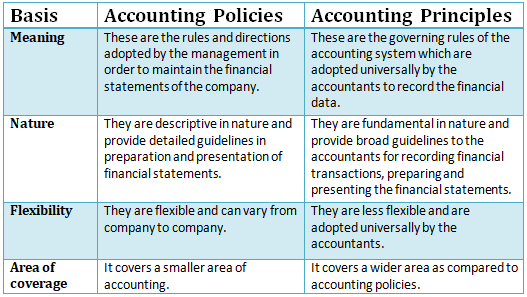To begin with, let me give you a brief explanation of both the terms i.e. Accounting policies and accounting principles- In order to maintain the financial statements, the company’s management adopts various Accounting Policies of its own. This generally includes the rules, the directions as to howRead more
To begin with, let me give you a brief explanation of both the terms i.e. Accounting policies and accounting principles-
In order to maintain the financial statements, the company’s management adopts various Accounting Policies of its own. This generally includes the rules, the directions as to how the financial statements will be prepared or how the valuation of depreciation would be done, and so on. These are flexible in nature and vary from company to company.
For Example 1, Johnson Co. uses FIFO (first in first out) method to value the inventory. That is to say that, while selling its product, it sells those goods or products which it has acquired or produced first.
It does not consider the LIFO or weighted average cost. The other company may adopt the other method as per its wish.
Example 2, Johnson Co. uses the straight-line method of depreciating an asset, whereas the other company can opt for a written down value method depending upon the need of the company.
So what I am trying to explain from this is that the accounting policies are flexible and can be adopted as per the needs of the company.
Accounting Principles are the rules which the accountants adopt universally for recording and reporting the financial data. It brings uniformity in accounting throughout the practice of accounting. These are generally less flexible in nature.
For Example, “Cost” is a principle. According to this accounting principle, an asset is recorded in the books at the price paid to acquire it and this cost will be the basis for all the subsequent accounting for the asset. However, asset market value may change over time, but for the accounting purpose, it continues to be shown at its book value i.e. at which it is acquired.
Some more examples would be of Matching principle, Consistency principle, Money measurement principle, etc.
Differences

Conclusion
The point is Accounting Principles are the broad direction to reach a goal and to reach that goal helps the accounting policies.
See less





A profit and loss account is a financial statement which shows the net profit or net loss of an enterprise for an accounting period. It reports all the indirect expenses and indirect income including gross profit or loss derived from trading accounts for an accounting period. When the total revenueRead more
A profit and loss account is a financial statement which shows the net profit or net loss of an enterprise for an accounting period. It reports all the indirect expenses and indirect income including gross profit or loss derived from trading accounts for an accounting period.
When the total revenue i.e. credit side of profit and loss a/c is more than the total of expenses i.e. the debit side of profit and loss a/c, it results in net profit whereas when the total revenue is less than the total of expenses, it results in a net loss.
The debit balance of the profit and loss account is the net loss incurred during the accounting period by an enterprise. It is transferred to a capital account thereby reducing the capital or can be shown as a debit balance on the asset side.
Accounting entry for loss transferred is as follows :
Capital A/c …Dr.
To Profit & Loss A/c
(being net loss transferred to capital account)
Example
A Business has a total income of $50,000 in an accounting year and has expenses amounting to $60,000 in that particular year. The profit and loss account will show a net loss of $10,000 ($60,000-50,000). Net loss will be transferred to capital A/c. Capital of the business will be reduced by $10,000. This loss can also be shown on the asset side of the balance sheet.
Extract of a Profit and loss a/c showing net loss is as under:
Profit and loss A/c for the year ended …..
The debit balance for a non-corporate entity is shown as a reduction from the capital account
Extract of the Balance sheet showing the debit balance of Profit & Loss A/c is as under :
Balance Sheet as on…
Less: Profit & Loss A/c
While the Debit balance of profit and Loss A/c of a corporate entity is shown as a reduction in Reserves and surplus. If the business doesn’t have reserves then the debit balance is shown on the asset side.
Extract of the Balance sheet showing the debit balance of Profit & Loss A/c is as under :
Balance Sheet as on..
Less: Profit & Loss A/c
Conclusion: Debit balance of profit and loss a/c represents that expenses are more than the income of a business in an accounting period. Debit balance of profit and loss a/c indicates that company need to increase its income or cut down on unnecessary expenses.
The business needs to find out the reason of excessive expenses because accumulated losses are not good for the health of the company.
See less